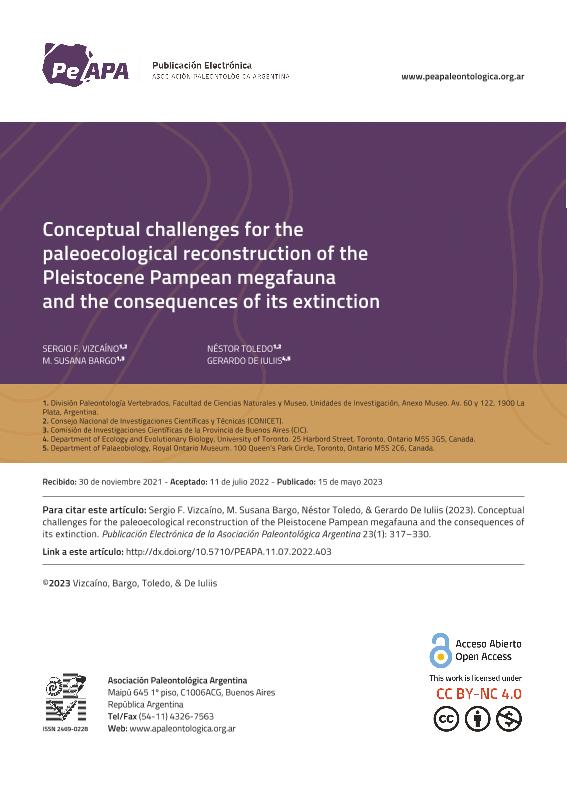Artículo
La Megafauna Pampeana del Pleistoceno (MPP) puede considerarse como el conjunto formado principalmente por grandes mamíferos (i.e., masa corporal ≥ 45 kg) que habitaron lo que actualmente se considera región pampeana durante el Pleistoceno y se extinguieron cerca de la transición Pleistoceno–Holoceno. Esta contribución aborda varias cuestiones conceptuales que pueden orientar los esfuerzos futuros en su reconstrucción y considerar las posibles consecuencias de su extinción. Primero, abordamos el concepto de megafauna, instando a su definición explícita y contextualización en cada investigación, como un medio para evitar la ambigüedad conceptual. En segundo lugar, llamamos la atención sobre los riesgos de sucumbir demasiado fácilmente a la tentación de emplear un enfoque simplista que asuma que los taxones extintos tenían prácticamente los mismos requisitos biológicos que los de sus contrapartes existentes. Señalamos que dentro de la MPP, la abundancia de taxones relacionados lejanamente o muy distintos morfológicamente de sus homólogos actuales plantea desafíos importantes para comprender su paleobiología. Las interpretaciones paleobiológicas no necesitan ser estrictamente restringidas filogenéticamente y las interpretaciones basadas en la filogenia deben aplicarse después de una revisión crítica. En tercer lugar, consideramos la paleoecología de la MPP desde una perspectiva metabólica: dado que estaba claramente dominada por megaherbívoros supuestamente hipometabólicos (xenartros), no existe una contraparte clara entre las faunas vivientes. En cuarto lugar, llamamos la atención sobre el hecho de que la pérdida de la MPP puede haber dejado un legado perdurable pero poco reconocido sobre el funcionamiento del ecosistema contemporáneo de la región pampeana. La extinción de la MPP produjo un enorme vacío ecológico en el gremio de herbívoros durante el Holoceno que persistió durante unos 6.000 años, hasta que fue ocupado, al menos en parte, por rebaños de ganado introducido desde el siglo XVI. The Pleistocene Pampean Megafauna (PPM) may be considered as the assemblage consisting mainly of large mammals (i.e., bodymass ≥ 45 kg) that inhabited what is currently considered the Pampean Region during the Pleistocene and became extinct near the Pleistocene–Holocene transition. This contribution addresses several conceptual issues that may guide future efforts in its reconstruction and to consider potential consequences of its extinction. First, we approach the concept of megafauna by urging its explicit definition and contextualization in every investigation as a means of avoiding conceptual ambiguity. Second, we call attention to the risks of succumbing too readily to the temptation of employing a simplistic approach that assumes that extinct taxa had virtually the same biological requirements as those of their extant counterparts. We claim that within the PPM the abundance of taxa distantly related to or markedly distinct morphologically from their living counterparts poses significant challenges for understanding their paleobiology. Paleobiological interpretations need not be rigidly phylogenetically restricted, and phylogenetically based interpretations require critical assessment before their application. Third, we consider the paleoecology of the PPM from a metabolic perspective: as it was clearly dominated by allegedly hypometabolic megaherbivores (xenarthrans), there is no clear counterpart among living faunas. Fourth, we call attention to the fact that the loss of the PPM may have left in its wake an enduring but little-recognized legacy on the functioning of the contemporary ecosystem of the Pampean Region. Extinction of the PPM opened an enormous ecological chasm in the herbivore guild during the Holocene that persisted for about 6000 years, until it was filled, at least in part, by herds of cattle introduced since the sixteenth century.
Desafíos conceptuales para la reconstrucción paleoecológica de la megafauna pampeana y las consecuencias de su extinción
Título:
Conceptual challenges for the paleoecological reconstruction of the Pleistocene Pampean Megafauna and the consequences of its extinction
Fecha de publicación:
05/2023
Editorial:
Asociación Paleontológica Argentina
Revista:
Publicación Electrónica de la Asociación Paleontológica Argentina
e-ISSN:
2469-0228
Idioma:
Inglés
Tipo de recurso:
Artículo publicado
Clasificación temática:
Resumen
Palabras clave:
CENOZOICO
,
MEGAFAUNA
,
PALEOECOLOGÍA
,
ACTUALISMO
Archivos asociados
Licencia
Identificadores
Colecciones
Articulos(CCT - LA PLATA)
Articulos de CTRO.CIENTIFICO TECNOL.CONICET - LA PLATA
Articulos de CTRO.CIENTIFICO TECNOL.CONICET - LA PLATA
Citación
Vizcaíno, Sergio Fabián; Bargo, María Susana; Toledo, Néstor; De Iuliis, Gerardo; Desafíos conceptuales para la reconstrucción paleoecológica de la megafauna pampeana y las consecuencias de su extinción; Asociación Paleontológica Argentina; Publicación Electrónica de la Asociación Paleontológica Argentina; 23; 1; 5-2023; 317-330
Compartir
Altmétricas




